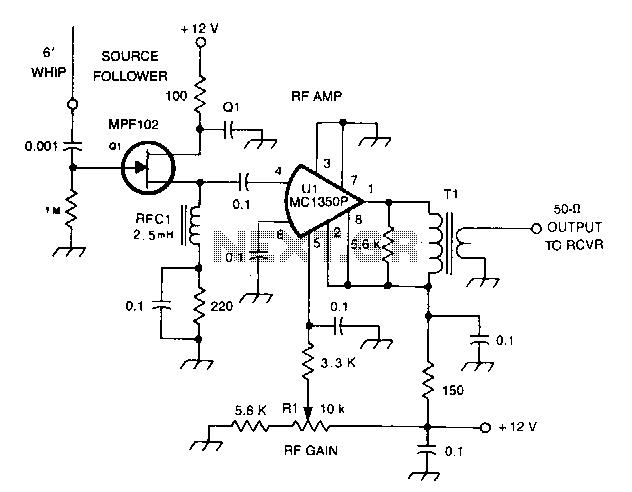
Active-antenna

All capacitors in this circuit are disc ceramic. Fixed-value resistors are 1/4 or 1/2-W carbon. R1 controls the gain of U1. RFC1 is a miniature 2.5mH RF choke. More: T1 has 30 primary turns of #28 enamel wire on an Amidon FT50-43 ferrite toroid core, and the secondary has four turns of #28 wire.
This circuit employs disc ceramic capacitors, which are known for their reliability and stability across a range of frequencies. The fixed-value resistors utilized are either 1/4 or 1/2-W carbon types, chosen for their low noise characteristics and sufficient power handling capability for typical applications. Resistor R1 plays a crucial role in the circuit by controlling the gain of operational amplifier U1, enabling precise adjustments to the amplification level based on the application requirements.
The circuit also includes RFC1, a miniature RF choke rated at 2.5mH, which serves to block high-frequency signals while allowing DC or low-frequency signals to pass. This component is vital in maintaining signal integrity and preventing unwanted oscillations in RF applications.
Transformer T1 is constructed with 30 primary turns of #28 enamel-coated wire wound on an Amidon FT50-43 ferrite toroid core. The choice of a ferrite toroid core is essential for minimizing electromagnetic interference and achieving efficient magnetic coupling. The secondary side of the transformer consists of four turns of #28 wire, designed to optimize the voltage transformation ratio and ensure compatibility with the circuit's operational parameters.
The design of this circuit emphasizes the importance of component selection and configuration, allowing for effective signal processing and amplification while maintaining high performance and reliability.All capacitors in this circuit are disc ceramic. Fixed-value resistors are 1/.-or 1/2-W carbon. Rl controls the gain of Ul. RFCl is a miniature 2.5mH rf choke. Tl has 30 primary turns of #28 enamel wire on an Amidon FT50 -43 ferrite toroid core, and the secondary has four turns of #28 wire. 🔗 External reference
This circuit employs disc ceramic capacitors, which are known for their reliability and stability across a range of frequencies. The fixed-value resistors utilized are either 1/4 or 1/2-W carbon types, chosen for their low noise characteristics and sufficient power handling capability for typical applications. Resistor R1 plays a crucial role in the circuit by controlling the gain of operational amplifier U1, enabling precise adjustments to the amplification level based on the application requirements.
The circuit also includes RFC1, a miniature RF choke rated at 2.5mH, which serves to block high-frequency signals while allowing DC or low-frequency signals to pass. This component is vital in maintaining signal integrity and preventing unwanted oscillations in RF applications.
Transformer T1 is constructed with 30 primary turns of #28 enamel-coated wire wound on an Amidon FT50-43 ferrite toroid core. The choice of a ferrite toroid core is essential for minimizing electromagnetic interference and achieving efficient magnetic coupling. The secondary side of the transformer consists of four turns of #28 wire, designed to optimize the voltage transformation ratio and ensure compatibility with the circuit's operational parameters.
The design of this circuit emphasizes the importance of component selection and configuration, allowing for effective signal processing and amplification while maintaining high performance and reliability.All capacitors in this circuit are disc ceramic. Fixed-value resistors are 1/.-or 1/2-W carbon. Rl controls the gain of Ul. RFCl is a miniature 2.5mH rf choke. Tl has 30 primary turns of #28 enamel wire on an Amidon FT50 -43 ferrite toroid core, and the secondary has four turns of #28 wire. 🔗 External reference